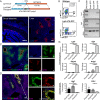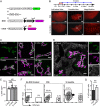Lgr5+ pericentral hepatocytes are self-maintained in normal liver regeneration and susceptible to hepatocarcinogenesis
- PMID: 31488716
- PMCID: PMC6765306
- DOI: 10.1073/pnas.1908099116
Lgr5+ pericentral hepatocytes are self-maintained in normal liver regeneration and susceptible to hepatocarcinogenesis
Abstract
Emerging evidence suggests that hepatocytes are primarily maintained by self-renewal during normal liver homeostasis, as well as in response to a wide variety of hepatic injuries. However, how hepatocytes in distinct anatomic locations within the liver lobule are replenished under homeostasis and injury-induced regeneration remains elusive. Using a newly developed bacterial artificial chromosome (BAC)-transgenic mouse model, we demonstrate that Lgr5 expression in the liver is restricted to a unique subset of hepatocytes most adjacent to the central veins. Genetic lineage tracing revealed that pericentral Lgr5+ hepatocytes have a long lifespan and mainly contribute to their own lineage maintenance during postnatal liver development and homeostasis. Remarkably, these hepatocytes also fuel the regeneration of their own lineage during the massive and rapid regeneration process following two-thirds partial hepatectomy. Moreover, Lgr5+ hepatocytes are found to be the main cellular origin of diethylnitrosamine (DEN)-induced hepatocellular carcinoma (HCC) and are highly susceptible to neoplastic transformation triggered by activation of Erbb pathway. Our findings establish an unexpected self-maintaining mode for a defined subset of hepatocytes during liver homeostasis and regeneration, and identify Lgr5+ pericentral hepatocytes as major cells of origin in HCC development.
Keywords: Lgr5; hepatocellular carcinoma; hepatocyte; lineage tracing; liver regeneration.
Conflict of interest statement
The authors declare no conflict of interest.
Figures





References
-
- Kopp J. L., Grompe M., Sander M., Stem cells versus plasticity in liver and pancreas regeneration. Nat. Cell Biol. 18, 238–245 (2016). - PubMed
-
- Miyajima A., Tanaka M., Itoh T., Stem/progenitor cells in liver development, homeostasis, regeneration, and reprogramming. Cell Stem Cell 14, 561–574 (2014). - PubMed
Publication types
MeSH terms
Substances
LinkOut - more resources
Full Text Sources
Molecular Biology Databases
Research Materials
Miscellaneous

